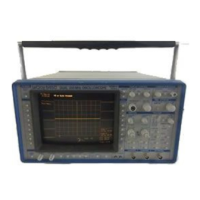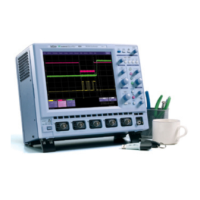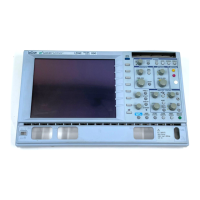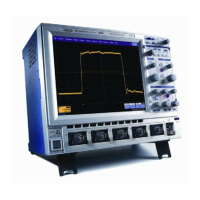When set to the largest possible value of 6 LSB, the waveforms are
offset by up to ±.2 vertical divisions (remember that a vertical
division corresponds to 32 least significant bits of the ADC). In this
case, care must be taken that the waveform to be averaged is contained
within 1/5 of a vertical division from the top and the bottom of the
display grid; otherwise overflows or under-flows might occur. Whenever
dithering is ON, the displays of CHANNELS 1 or 2 vary vertically with
the dithering offset. Their waveform descriptors take the additional
offset into account so that waveforms, as read out by remote control,
and cursor measurements are always correct.
Offset dithering is of interest when the waveform to be averaged is
already relatively "clean", i.e. contains noise variations of the order
of 1/5 of a division or less. In this case, dithering makes the
sequentially acquired waveforms use slightly different portions of the
ADC. Thus the differential non-llnearities (that any flash ADC has) are
averaged out. It can be expected that the differential non-linearities
are reduced by up to a factor of 4 when using 6 LSB dithering.
Waveforms which have high levels of noise (>1/5 of a vertical division)
do their own "dithering", making artificial offset variations
unnecessary.
10.2.2 Continuous Average
Continuous averaging (sometimes called exponential averaging) consists
of the repeated addition, with UNEQUAL weight, of recurrences of the
source waveform. Each newly acquired waveform is added to the
accumulated average according to the formula:
S(i,new) ffi
[ ] [ ]
(N-I) S(i,old) + --
N
N
Where
i
W(i)
S(i,old)
S(i,new)
N
Index over all data points of the waveforms
Newly acquired waveform
"old" accumulated average
"new" accumulated average
May be 2, 4, 8, 16, 32, 64 or 128
The coefficients (N-I)/N and I/N are the weighting factors which
determine the speed at which the continuous average follows any
modification of the source waveform. Note that they add up to the value
of i, so that the continuous average of noisy, but otherwise
unmodified, waveforms resembles the summed average of such waveforms.
10-4
gPOl Waveform Processing Option

